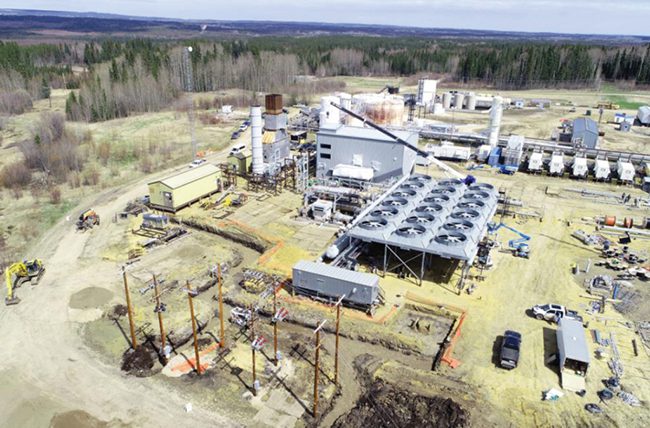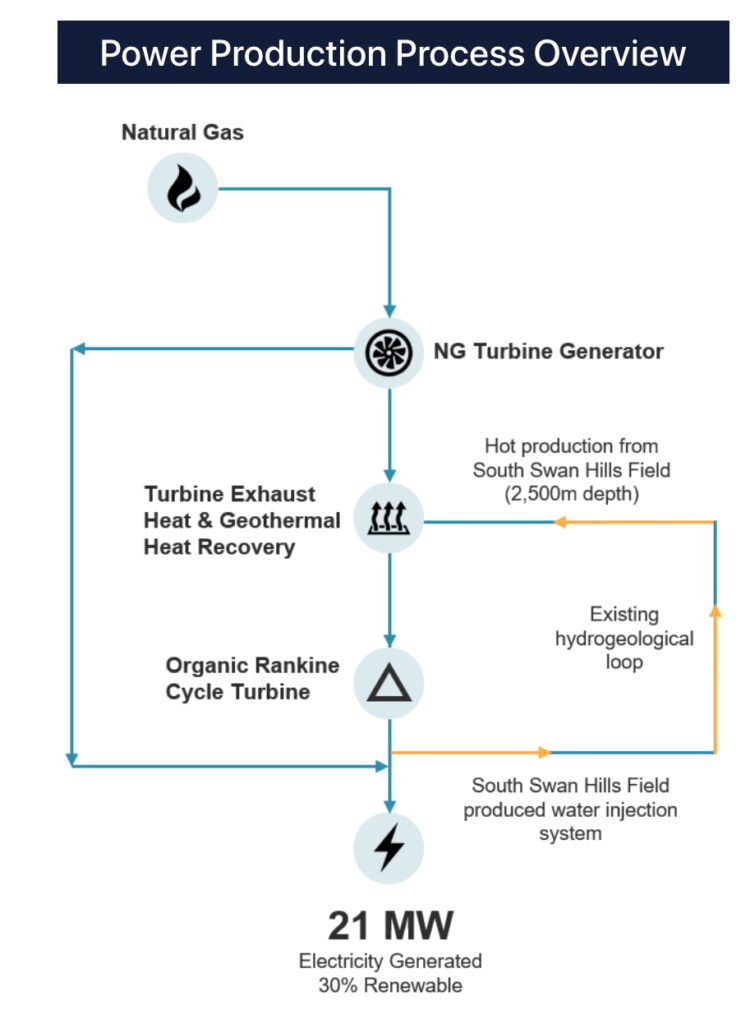Canada Starts Up First Geothermal ‘Co-Production’ Power Project at Active Legacy Oil Field

A pioneering 21-MW power project that economically produces geothermal power with co-produced hydrocarbon fluids from an enhanced oil recovery (EOR) operation is now commercially operating in Alberta, Canada.
The South Swan Hills Geothermal Project owned by Razor Energy Corp. subsidiary FutEra Power began commercial operations on March 22. Uniquely positioned over a hot spot" in the Western Canadian Sedimentary Basin, the CA$49 million project harvests 84 producing wells, which have the potential to deliver up to 120,000 billion barrels a day of water heated to between 90C and 100C. At least 14 of those wells are sited in the field at depths of 2,500 meters (m) and have temperatures of 100C, FutEra suggests.
 The South Swan Hills Geothermal Project is positioned over a unique hot spot within the Western Canadian Sedimentary Basin. The world-class reservoir" is encased in shale, eliminating the concern of reservoir cooling and/or heat escape, owner Razor Energy says. Courtesy: Razor Energy
The South Swan Hills Geothermal Project is positioned over a unique hot spot within the Western Canadian Sedimentary Basin. The world-class reservoir" is encased in shale, eliminating the concern of reservoir cooling and/or heat escape, owner Razor Energy says. Courtesy: Razor Energy
The hot water is then gathered and delivered to the South Swan Hills Geothermal Project via pipelines of a combined 108 kilometers (km) in length. At the plant, an Organic Rankine Cycle (ORC) turbine, which began operations in January 2023, captures the geothermal heat from the production fluid. A September 2022-installed 15-MW natural gas turbine (NGT), meanwhile, enhances the ORC working fluid temperature to optimize efficiency via exhaust heat recovery," FutEra said. In addition, the project utilizes its waste heat to heat the water back up to a hot enough temperature" and run a secondary generator while at the same time cooling the power plant.
The end result is an output of 21 MW of power, roughly 30% of which is derived from a renewable source. However, the project provides Alberta with baseload power. Both the ORC and the NGT have grid interconnections, which enable direct sales of electricity to the Alberta electricity grid at merchant power prices," FutEra noted. While neither the ORC or NGT are subject to hedging for pricing or to commitments to any level of power generation beyond voluntary dispatch commitments, the NGT and the ORC systems have been running in steady state while optimization efforts are underway to get to design capacity," it said.
 South Swan Hills is a 21-MW co-produced geothermal and natural gas hybrid power project" that uses legacy infrastructure. Courtesy: FutEra
South Swan Hills is a 21-MW co-produced geothermal and natural gas hybrid power project" that uses legacy infrastructure. Courtesy: FutEra
The project got its start in 2017 when Razor Energy, a junior" oil and gas company based in Calgary, Alberta, saw a unique opportunity to enhance its existing EOR operation at Swan Hills. Legacy oil and gas fields in Alberta, and globally, face challenges with lower production levels and high fixed costs," the company noted. However, these fields also have practical advantages when considering the existing infrastructure, reservoir characteristics, wells, and operational footprints."
While Swan Hills-one of the largest oil and gas reservoirs discovered in Alberta-has produced light oil since 1960, its reservoir had been slowly depleted and replaced with water as part of a secondary oil recovery technique known as waterflooding."
The Swan Hills region is now in the late stages of its lifecycle, so what typically happens is people will inject water pressure into the reservoir to try and drive the remaining hydrocarbons out of it. A consequence of doing that is the water heats up and is then reproduced with the hydrocarbon," said Jonathan Banks, director of Geothermal Energy and Development with the University of Alberta's Future Energy Systems program. In Swan Hills, they are producing between 95% to 98% water, which is still profitable for them, but the question now is what can we do with all of this hot wastewater to add value to the operation?" said Banks.
Razor Energy saw a crucial source of untapped value in the large volumes of hot production fluids harvested as a co-produced byproduct of the upstream oil and gas production operation at Swan Hills. Supporting the geothermal power project's long-term viability, meanwhile, is that 60 years of data suggest water temperatures have remained hot enough to generate power, it said.
The reason that is important is because it's called security of supply. In geothermal that matters a lot because you've de-risked your source significantly," noted Lisa Mueller, president and CEO for FutEra Power. There's billions of barrels of fluids in place and on an annualized basis with this project we're only attempting to replace 2% to 3% of the overall volume of the reservoir," she added.
 Alberta-based oil and gas firm Razor Energy in March 2023 began operating a commercial-scale project to produce economic geothermal power with co-produced hydrocarbon fluids in the South Swan Hills oil field in Central Alberta. Courtesy: Razor Energy
Alberta-based oil and gas firm Razor Energy in March 2023 began operating a commercial-scale project to produce economic geothermal power with co-produced hydrocarbon fluids in the South Swan Hills oil field in Central Alberta. Courtesy: Razor Energy
As a significant benefit to project economics, the plant utilizes co-production. Co-production means no new surface land footprint is required as the project utilizes existing assets such as processing infrastructure, producing wells, produced water reinjection system, and an operating gathering and distribution system," FutEra explained. Using existing assets yield cumulative, and substantive, effects of reducing typical geothermal project capital outlay, improving security of heat supply, and improving economic returns."
The company suggested the co-production approach could also allow Alberta's fledgling geothermal industry" to thrive alongside its world-class oil and gas operations, safety standards, and regulatory best practices." While Razor Energy noted the project stands out as a demonstration of creative and practical co-produced geothermal energy production," it suggests the approach could be applied anywhere oil and gas is produced.
South Swan Hills notably operates under a dedicated geothermal facility lease-the first of its kind. And while the pilot project was privately financed by Razor and Arena Investors, a U.S.-based institutional asset manager, it received substantial backing from the Canadian government. Grants include CA$7.75 million under Natural Resource Canada's Clean Growth Program, a separate CA$2 million contribution from Alberta Innovates, and CA$10 million from Emissions Reduction Alberta, which supports climate technology innovation within the province.
By 2019, two years after the project was first publicly unveiled, Razor Energy had completed the plant's engineering design, and it had wrapped up its full regulatory review and stakeholder engagement processes. The project received the Alberta Utilities Commission's approval to build the plant and connect it to the grid in October 2019.
FutEra is now readying for the project's next phase, which will entail adding solar generation to the plant's footprint. The company is also exploring adding carbon capture with usage and/or sequestration," it said. Swan Hills, notably, hosted an EOR carbon dioxide injection pilot in 2007, and minimal capital" would be required to restart injection operations. The objective is to create a net negative carbon emitting traditional oil and gas asset," the company said.
Meanwhile, future endeavors could focus on larger, lower emissions natural gas and renewable electricity generation projects with similar themes-leveraging Razor and other oil and gas producer's operations to create financial and tactically advantaged development scenarios and prospective competitive returns to investors," FutEra said. For now, Razor and FutEra are eyeing a second co-produced geothermal power project. While that project is still in the design phase, it could be ready to construct in 2023/24," FutEra said.
At least for now, South Swan Hills leads Canada's efforts to ramp up geothermal power production. Among other notable projects under development is DEEP Earth Energy Production Corp.'s 200-MW geothermal power facility in southeastern Saskatchewan. In February, DEEP formally kicked off the first 25-MW project stage, aiming for commissioning in 2026. The project will utilize a ribcage" layout, entailing the construction of first a 5-MW phase and then a 20-MW phase. It will comprise drilling of production and injection wells at depths of about 3.5 km and horizontally for an additional 3 km, and generate power with ORC technology. Geothermal power generation has the capacity to provide renewable, reliable baseload energy (24/7), and the DEEP project in Saskatchewan is anticipated to be the first Canadian 100% naturally sourced geothermal power facility," DEEP says.
-Sonal Patel is a POWER senior associate editor (@sonalcpatel,@POWERmagazine).
The post Canada Starts Up First Geothermal Co-Production' Power Project at Active Legacy Oil Field appeared first on POWER Magazine.